display Seat Alhambra 2008 Owner's Manual
[x] Cancel search | Manufacturer: SEAT, Model Year: 2008, Model line: Alhambra, Model: Seat Alhambra 2008Pages: 295, PDF Size: 7.83 MB
Page 5 of 295
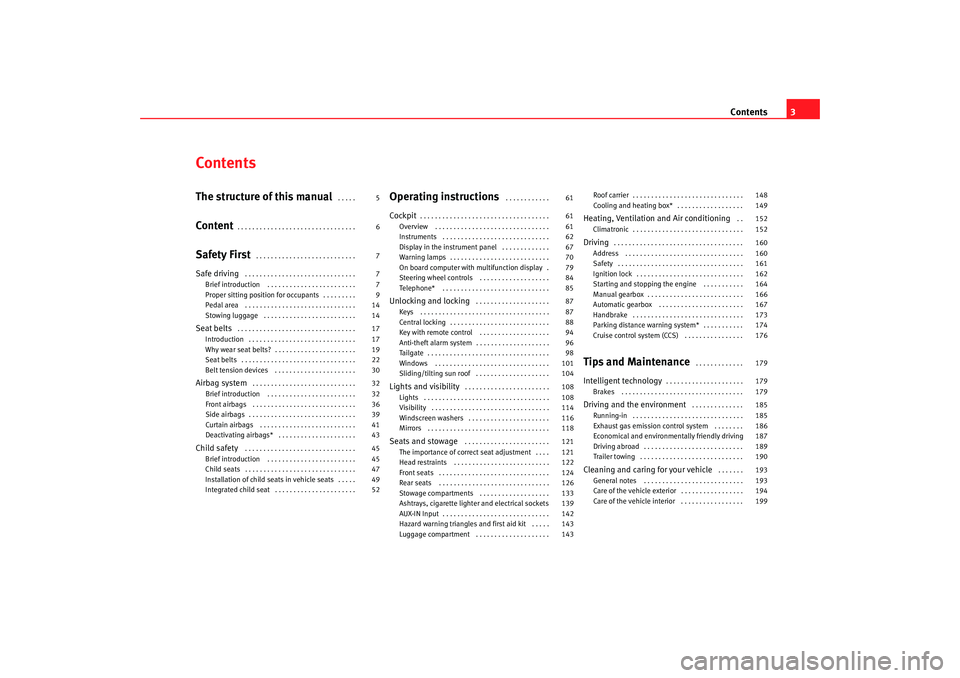
Contents3
ContentsThe structure of this manual
. . . . .
Content
. . . . . . . . . . . . . . . . . . . . . . . . . . . . . . . .
Safety First
. . . . . . . . . . . . . . . . . . . . . . . . . . .
Safe driving
. . . . . . . . . . . . . . . . . . . . . . . . . . . . . .
Brief introduction . . . . . . . . . . . . . . . . . . . . . . . .
Proper sitting position for occupants . . . . . . . . .
Pedal area . . . . . . . . . . . . . . . . . . . . . . . . . . . . . .
Stowing luggage . . . . . . . . . . . . . . . . . . . . . . . . .
Seat belts
. . . . . . . . . . . . . . . . . . . . . . . . . . . . . . . .
Introduction . . . . . . . . . . . . . . . . . . . . . . . . . . . . .
Why wear seat belts? . . . . . . . . . . . . . . . . . . . . . .
Seat belts . . . . . . . . . . . . . . . . . . . . . . . . . . . . . . .
Belt tension devices . . . . . . . . . . . . . . . . . . . . . .
Airbag system
. . . . . . . . . . . . . . . . . . . . . . . . . . . .
Brief introduction . . . . . . . . . . . . . . . . . . . . . . . .
Front airbags . . . . . . . . . . . . . . . . . . . . . . . . . . . .
Side airbags . . . . . . . . . . . . . . . . . . . . . . . . . . . . .
Curtain airbags . . . . . . . . . . . . . . . . . . . . . . . . . .
Deactivating airbags* . . . . . . . . . . . . . . . . . . . . .
Child safety
. . . . . . . . . . . . . . . . . . . . . . . . . . . . . .
Brief introduction . . . . . . . . . . . . . . . . . . . . . . . .
Child seats . . . . . . . . . . . . . . . . . . . . . . . . . . . . . .
Installation of child seats in vehicle seats . . . . .
Integrated child seat . . . . . . . . . . . . . . . . . . . . . .
Operating instructions
. . . . . . . . . . . .
Cockpit
. . . . . . . . . . . . . . . . . . . . . . . . . . . . . . . . . . .
Overview . . . . . . . . . . . . . . . . . . . . . . . . . . . . . . .
Instruments . . . . . . . . . . . . . . . . . . . . . . . . . . . . .
Display in the instrument panel . . . . . . . . . . . . .
Warning lamps . . . . . . . . . . . . . . . . . . . . . . . . . . .
On board computer with multifunction display .
Steering wheel controls . . . . . . . . . . . . . . . . . . .
Telephone* . . . . . . . . . . . . . . . . . . . . . . . . . . . . .
Unlocking and locking
. . . . . . . . . . . . . . . . . . . .
Keys . . . . . . . . . . . . . . . . . . . . . . . . . . . . . . . . . . .
Central locking . . . . . . . . . . . . . . . . . . . . . . . . . . .
Key with remote control . . . . . . . . . . . . . . . . . . .
Anti-theft alarm system . . . . . . . . . . . . . . . . . . . .
Tailgate . . . . . . . . . . . . . . . . . . . . . . . . . . . . . . . . .
Windows . . . . . . . . . . . . . . . . . . . . . . . . . . . . . . .
Sliding/tilting sun roof . . . . . . . . . . . . . . . . . . . .
Lights and visibility
. . . . . . . . . . . . . . . . . . . . . . .
Lights . . . . . . . . . . . . . . . . . . . . . . . . . . . . . . . . . .
Visibility . . . . . . . . . . . . . . . . . . . . . . . . . . . . . . . .
Windscreen washers . . . . . . . . . . . . . . . . . . . . . .
Mirrors . . . . . . . . . . . . . . . . . . . . . . . . . . . . . . . . .
Seats and stowage
. . . . . . . . . . . . . . . . . . . . . . .
The importance of correct seat adjustment . . . .
Head restraints . . . . . . . . . . . . . . . . . . . . . . . . . .
Front seats . . . . . . . . . . . . . . . . . . . . . . . . . . . . . .
Rear seats . . . . . . . . . . . . . . . . . . . . . . . . . . . . . .
Stowage compartments . . . . . . . . . . . . . . . . . . .
Ashtrays, cigarette lighter and electrical sockets
AUX-IN Input . . . . . . . . . . . . . . . . . . . . . . . . . . . . .
Hazard warning triangles and first aid kit . . . . .
Luggage compartment . . . . . . . . . . . . . . . . . . . . Roof carrier . . . . . . . . . . . . . . . . . . . . . . . . . . . . . .
Cooling and heating box* . . . . . . . . . . . . . . . . . .
Heating, Ventilation and Air conditioning
. .
Climatronic . . . . . . . . . . . . . . . . . . . . . . . . . . . . . .
Driving
. . . . . . . . . . . . . . . . . . . . . . . . . . . . . . . . . . .
Address . . . . . . . . . . . . . . . . . . . . . . . . . . . . . . . .
Safety . . . . . . . . . . . . . . . . . . . . . . . . . . . . . . . . . .
Ignition lock . . . . . . . . . . . . . . . . . . . . . . . . . . . . .
Starting and stopping the engine . . . . . . . . . . .
Manual gearbox . . . . . . . . . . . . . . . . . . . . . . . . . .
Automatic gearbox . . . . . . . . . . . . . . . . . . . . . . .
Handbrake . . . . . . . . . . . . . . . . . . . . . . . . . . . . . .
Parking distance warning system* . . . . . . . . . . .
Cruise control system (CCS) . . . . . . . . . . . . . . . .
Tips and Maintenance
. . . . . . . . . . . . .
Intelligent technology
. . . . . . . . . . . . . . . . . . . . .
Brakes . . . . . . . . . . . . . . . . . . . . . . . . . . . . . . . . .
Driving and the environment
. . . . . . . . . . . . . .
Running-in . . . . . . . . . . . . . . . . . . . . . . . . . . . . . .
Exhaust gas emission control system . . . . . . . .
Economical and environmentally friendly driving
Driving abroad . . . . . . . . . . . . . . . . . . . . . . . . . . .
Trailer towing . . . . . . . . . . . . . . . . . . . . . . . . . . . .
Cleaning and caring for your vehicle
. . . . . . .
General notes . . . . . . . . . . . . . . . . . . . . . . . . . . .
Care of the vehicle exterior . . . . . . . . . . . . . . . . .
Care of the vehicle interior . . . . . . . . . . . . . . . . .
5
6
7
7
7
9
14
14
17
17
19
22
30
32
32
36
39
41
43
45
45
47
49
52 61
61
61
62
67
70
79
84
85
87
87
88
94
96
98
101
104
108
108
114
116
118
121
121
122
124
126
133
139
142
143
143 148
149
152
152
160
160
161
162
164
166
167
173
174
176
179
179
179
185
185
186
187
189
190
193
193
194
199
alhambra_ingles_0708 Seite 3 Mittwoch, 10. September 2008 10:55 10
Page 36 of 295
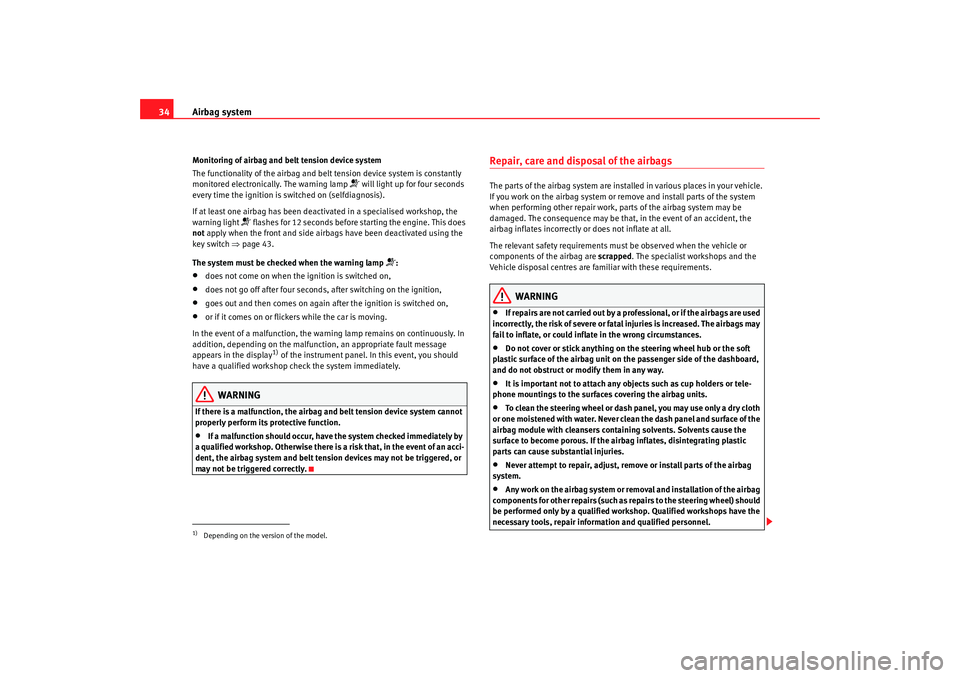
Airbag system
34Monitoring of airbag and belt tension device system
The functionality of the airbag and belt tension device system is constantly
monitored electronically. The warning lamp
will light up for four seconds
every time the ignition is switched on (selfdiagnosis).
If at least one airbag has been deactivated in a specialised workshop, the
warning light
flashes for 12 seconds before starting the engine. This does
not apply when the front and side airbags have been deactivated using the
key switch ⇒ page 43.
The system must be checked when the warning lamp
:
•
does not come on when the ignition is switched on,
•
does not go off after four seconds, after switching on the ignition,
•
goes out and then comes on again after the ignition is switched on,
•
or if it comes on or flickers while the car is moving.
In the event of a malfunction, the warning lamp remains on continuously. In
addition, depending on the malfunction, an appropriate fault message
appears in the display
1) of the instrument panel. In this event, you should
have a qualified workshop check the system immediately.
WARNING
If there is a malfunction, the airbag and belt tension device system cannot
properly perform its protective function.•
If a malfunction should occur, have the system checked immediately by
a qualified workshop. Otherwise there is a risk that, in the event of an acci-
dent, the airbag system and belt tension devices may not be triggered, or
may not be triggered correctly.
Repair, care and disposal of the airbagsThe parts of the airbag system are installed in various places in your vehicle.
If you work on the airbag system or remove and install parts of the system
when performing other repair work, parts of the airbag system may be
damaged. The consequence may be that, in the event of an accident, the
airbag inflates incorrectly or does not inflate at all.
The relevant safety requirements must be observed when the vehicle or
components of the airbag are scrapped. The specialist workshops and the
Vehicle disposal centres are familiar with these requirements.
WARNING
•
If repairs are not carried out by a professional, or if the airbags are used
incorrectly, the risk of severe or fatal injuries is increased. The airbags may
fail to inflate, or could inflate in the wrong circumstances.
•
Do not cover or stick anything on the steering wheel hub or the soft
plastic surface of the airbag unit on the passenger side of the dashboard,
and do not obstruct or modify them in any way.
•
It is important not to attach any objects such as cup holders or tele-
phone mountings to the surfaces covering the airbag units.
•
To clean the steering wheel or dash panel, you may use only a dry cloth
or one moistened with water. Never clean the dash panel and surface of the
airbag module with cleansers containing solvents. Solvents cause the
surface to become porous. If the airbag inflates, disintegrating plastic
parts can cause substantial injuries.
•
Never attempt to repair, adjust, remove or install parts of the airbag
system.
•
Any work on the airbag system or removal and installation of the airbag
components for other repairs (such as repairs to the steering wheel) should
be performed only by a qualified workshop. Qualified workshops have the
necessary tools, repair information and qualified personnel.
1)Depending on the version of the model.
alhambra_ingles_0708 Seite 34 Mittwoch, 10. September 2008 10:55 10
Page 63 of 295
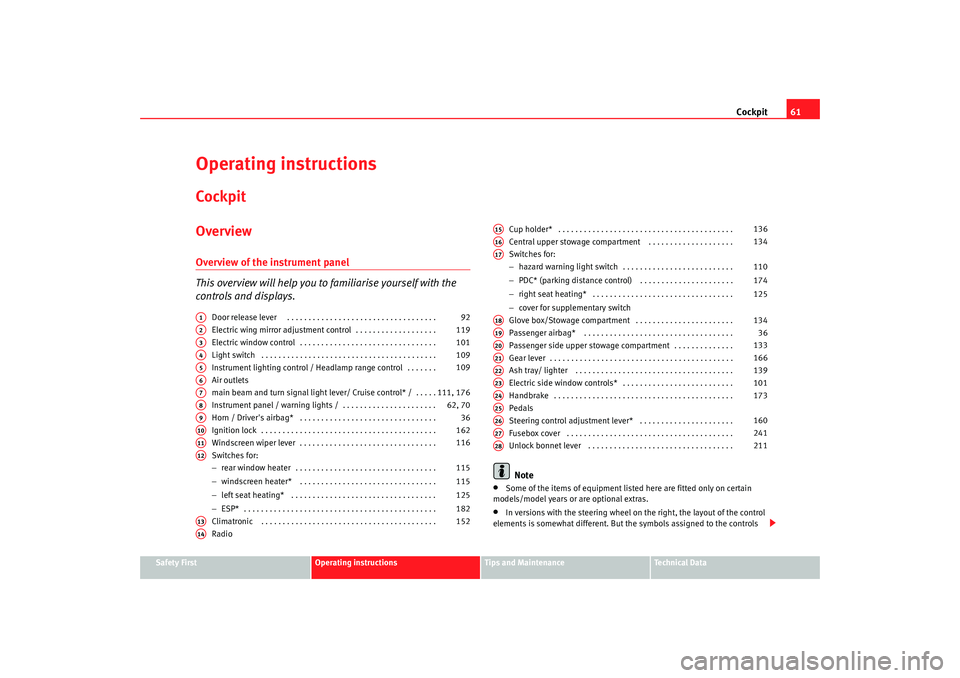
Cockpit61
Safety First
Operating instructions
Tips and Maintenance
Te c h n i c a l D a t a
Operating instructionsCockpitOverviewOverview of the instrument panel
This overview will help you to familiarise yourself with the
controls and displays.
Door release lever . . . . . . . . . . . . . . . . . . . . . . . . . . . . . . . . . . .
Electric wing mirror adjustment control . . . . . . . . . . . . . . . . . . .
Electric window control . . . . . . . . . . . . . . . . . . . . . . . . . . . . . . . .
Light switch . . . . . . . . . . . . . . . . . . . . . . . . . . . . . . . . . . . . . . . . .
Instrument lighting control / Headlamp range control . . . . . . .
Air outlets
main beam and turn signal light lever/ Cruise control* / . . . . .
Instrument panel / warning lights / . . . . . . . . . . . . . . . . . . . . . .
Horn / Driver's airbag* . . . . . . . . . . . . . . . . . . . . . . . . . . . . . . . .
Ignition lock . . . . . . . . . . . . . . . . . . . . . . . . . . . . . . . . . . . . . . . . .
Windscreen wiper lever . . . . . . . . . . . . . . . . . . . . . . . . . . . . . . . .
Switches for:
−rear window heater . . . . . . . . . . . . . . . . . . . . . . . . . . . . . . . . .
− windscreen heater* . . . . . . . . . . . . . . . . . . . . . . . . . . . . . . . .
− left seat heating* . . . . . . . . . . . . . . . . . . . . . . . . . . . . . . . . . .
− ESP* . . . . . . . . . . . . . . . . . . . . . . . . . . . . . . . . . . . . . . . . . . . . .
Climatronic . . . . . . . . . . . . . . . . . . . . . . . . . . . . . . . . . . . . . . . . .
Radio Cup holder* . . . . . . . . . . . . . . . . . . . . . . . . . . . . . . . . . . . . . . . . .
Central upper stowage compartment . . . . . . . . . . . . . . . . . . . .
Switches for:
−
hazard warning light switch . . . . . . . . . . . . . . . . . . . . . . . . . .
− PDC* (parking distance control) . . . . . . . . . . . . . . . . . . . . . .
− right seat heating* . . . . . . . . . . . . . . . . . . . . . . . . . . . . . . . . .
− cover for supplementary switch
Glove box/Stowage compartment . . . . . . . . . . . . . . . . . . . . . . .
Passenger airbag* . . . . . . . . . . . . . . . . . . . . . . . . . . . . . . . . . . .
Passenger side upper stowage compartment . . . . . . . . . . . . . .
Gear lever . . . . . . . . . . . . . . . . . . . . . . . . . . . . . . . . . . . . . . . . . . .
Ash tray/ lighter . . . . . . . . . . . . . . . . . . . . . . . . . . . . . . . . . . . . .
Electric side window controls* . . . . . . . . . . . . . . . . . . . . . . . . . .
Handbrake . . . . . . . . . . . . . . . . . . . . . . . . . . . . . . . . . . . . . . . . . .
Pedals
Steering control adjustment lever* . . . . . . . . . . . . . . . . . . . . . .
Fusebox cover . . . . . . . . . . . . . . . . . . . . . . . . . . . . . . . . . . . . . . .
Unlock bonnet lever . . . . . . . . . . . . . . . . . . . . . . . . . . . . . . . . . .
Note
•
Some of the items of equipment listed here are fitted only on certain
models/model years or are optional extras.
•
In versions with the steering wheel on the right, the layout of the control
elements is somewhat different. But the symbols assigned to the controls
A1
92
A2
119
A3
101
A4
109
A5
109
A6A7
111, 176
A8
62, 70
A9
36
A10
162
A11
116
A12
115
115
125
182
A13
152
A14
A15
136
A16
134
A17
110
174
125
A18
134
A19
36
A20
133
A21
166
A22
139
A23
101
A24
173
A25A26
160
A27
241
A28
211
alhambra_ingles_0708 Seite 61 Mittwoch, 10. September 2008 10:55 10
Page 64 of 295
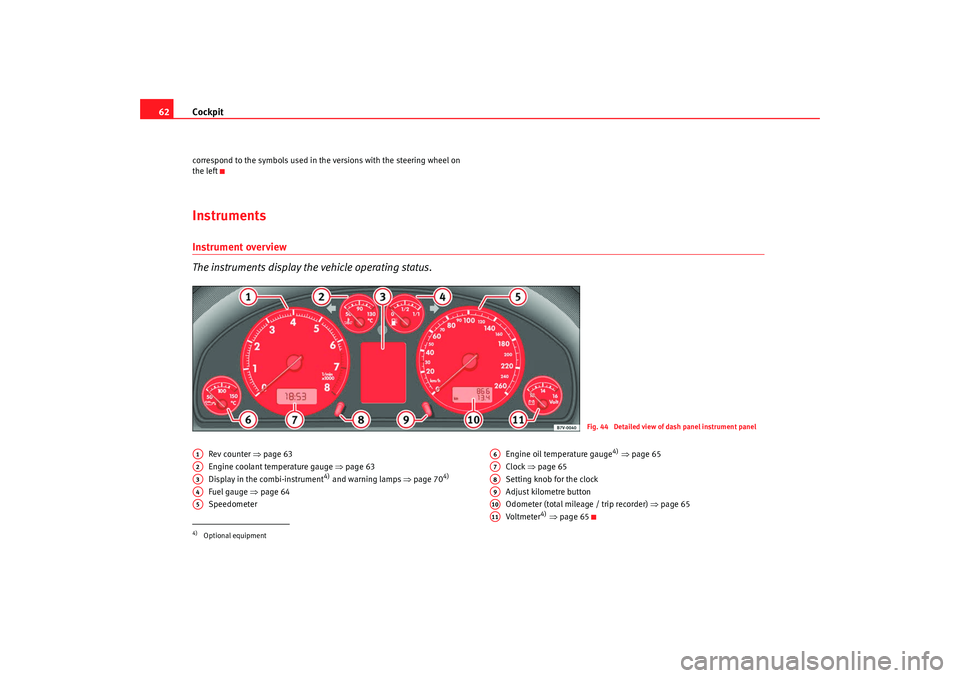
Cockpit
62correspond to the symbols used in the versions with the steering wheel on
the leftInstrumentsInstrument overview
The instruments display the vehicle operating status.
Rev counter ⇒page 63
Engine coolant temperature gauge ⇒ page 63
Display in the combi-instrument
4) and warning lamps ⇒page 70
4)
Fuel gauge ⇒ page 64
Speedometer Engine oil temperature gauge
4)
⇒ page 65
Clock ⇒page 65
Setting knob for the clock
Adjust kilometre button
Odometer (total mileage / trip recorder) ⇒page 65
Vo ltm e te r
4) ⇒ page 65
Fig. 44 Detailed view of dash panel instrument panel
4)Optional equipmentA1A2A3A4A5
A6A7A8A9A10A11
alhambra_ingles_0708 Seite 62 Mittwoch, 10. September 2008 10:55 10
Page 65 of 295
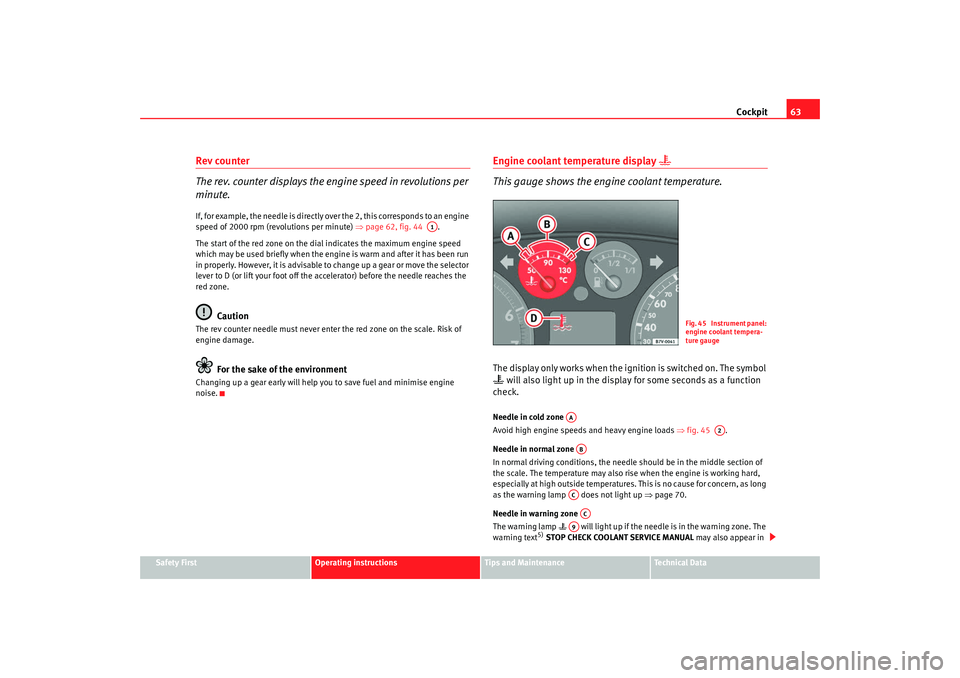
Cockpit63
Safety First
Operating instructions
Tips and Maintenance
Te c h n i c a l D a t a
Rev counter
The rev. counter displays the engine speed in revolutions per
minute.If, for example, the needle is directly over the 2, this corresponds to an engine
speed of 2000 rpm (revolutions per minute) ⇒page 62, fig. 44 .
The start of the red zone on the dial indicates the maximum engine speed
which may be used briefly when the engine is warm and after it has been run
in properly. However, it is advisable to change up a gear or move the selector
lever to D (or lift your foot off the accelerator) before the needle reaches the
red zone.
Caution
The rev counter needle must never enter the red zone on the scale. Risk of
engine damage.
For the sake of the environment
Changing up a gear early will help you to save fuel and minimise engine
noise.
Engine coolant temperature display
This gauge shows the engine coolant temperature.The display only works when the ignition is switched on. The symbol will also light up in the display for some seconds as a function
check.Needle in cold zone
Avoid high engine speeds and heavy engine loads ⇒fig. 45 .
Needle in normal zone
In normal driving conditions, the needle should be in the middle section of
the scale. The temperature may also rise when the engine is working hard,
especially at high outside temperatures. This is no cause for concern, as long
as the warning lamp does not light up ⇒page 70.
Needle in warning zone
The warning lamp will light up if the needle is in the warning zone. The
warning text
5) STOP CHECK COOLANT SERVICE MANUAL may also appear in
A1
Fig. 45 Instrument panel:
engine coolant tempera-
ture gauge
AA
A2
ABACAC
A9
alhambra_ingles_0708 Seite 63 Mittwoch, 10. September 2008 10:55 10
Page 66 of 295
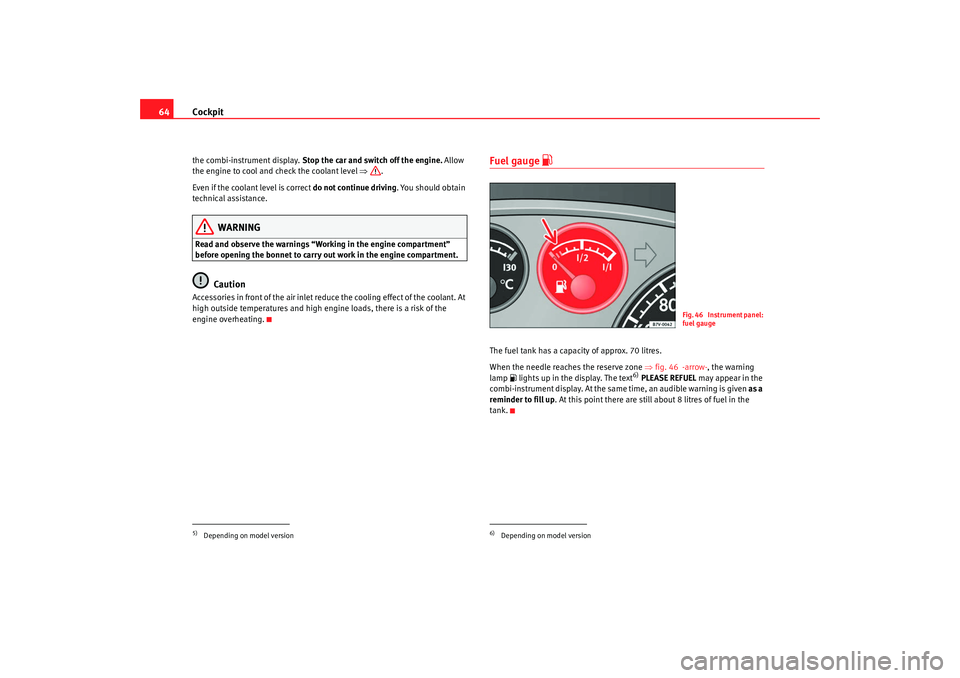
Cockpit
64the combi-instrument display. Stop the car and switch off the engine. Allow
the engine to cool and check the coolant level ⇒.
Even if the coolant level is correct do not continue driving . You should obtain
technical assistance.
WARNING
Read and observe the warnings “Working in the engine compartment”
before opening the bonnet to carry out work in the engine compartment.
Caution
Accessories in front of the air inlet reduce the cooling effect of the coolant. At
high outside temperatures and high engine loads, there is a risk of the
engine overheating.
Fuel gauge
The fuel tank has a capacity of approx. 70 litres.
When the needle reaches the reserve zone ⇒fig. 46 -arrow- , the warning
lamp lights up in the display. The text
6) PLEASE REFUEL may appear in the
combi-instrument display. At the same time, an audible warning is given as a
reminder to fill up. At this point there are still about 8 litres of fuel in the
tank.
5)Depending on model version
6)Depending on model version
F i g . 4 6 I n s t r u m e n t p a n e l :
fuel gauge
alhambra_ingles_0708 Seite 64 Mittwoch, 10. September 2008 10:55 10
Page 67 of 295
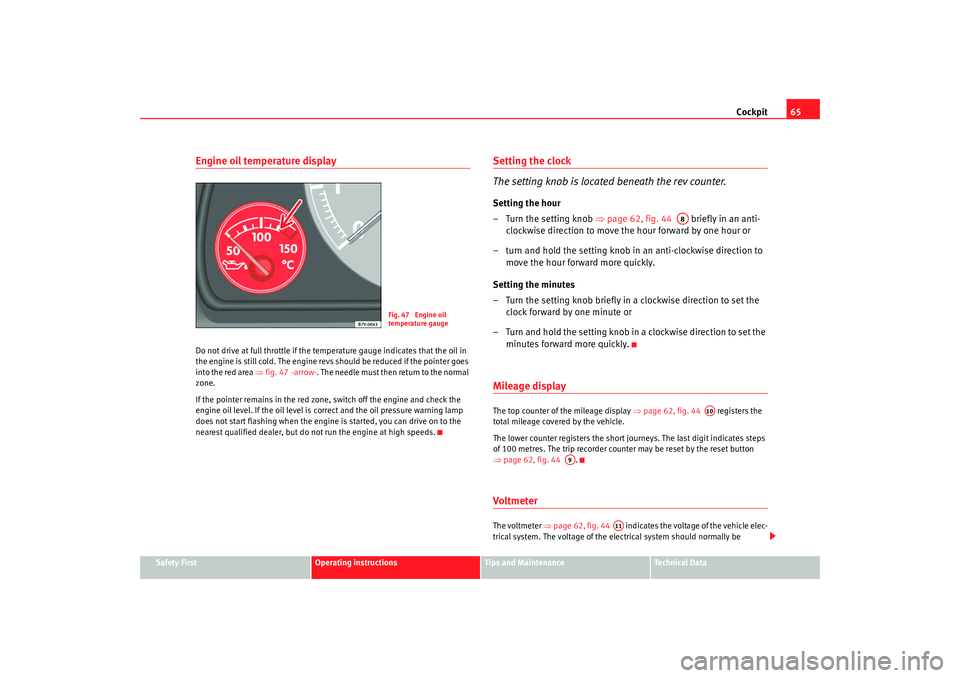
Cockpit65
Safety First
Operating instructions
Tips and Maintenance
Te c h n i c a l D a t a
Engine oil temperature displayDo not drive at full throttle if the temperature gauge indicates that the oil in
the engine is still cold. The engine revs should be reduced if the pointer goes
into the red area ⇒fig. 47 -arrow- . The needle must then return to the normal
zone.
If the pointer remains in the red zone, switch off the engine and check the
engine oil level. If the oil level is correct and the oil pressure warning lamp
does not start flashing when the engine is started, you can drive on to the
nearest qualified dealer, but do not run the engine at high speeds.
Setting the clock
The setting knob is located beneath the rev counter.Setting the hour
– Turn the setting knob ⇒ page 62, fig. 44 briefly in an anti-
clockwise direction to move the hour forward by one hour or
– turn and hold the setting knob in an anti-clockwise direction to move the hour forward more quickly.
Setting the minutes
– Turn the setting knob briefly in a clockwise direction to set the clock forward by one minute or
– Turn and hold the setting knob in a clockwise direction to set the minutes forward more quickly.Mileage displayThe top counter of the mileage display ⇒page 62, fig. 44 registers the
total mileage covered by the vehicle.
The lower counter registers the short journeys. The last digit indicates steps
of 100 metres. The trip recorder counter may be reset by the reset button
⇒ page 62, fig. 44 .Voltmeter The voltmeter ⇒page 62, fig. 44 indicates the voltage of the vehicle elec-
trical system. The voltage of the electrical system should normally be
Fig. 47 Engine oil
temperature gauge
A8
A10
A9
A11
alhambra_ingles_0708 Seite 65 Mittwoch, 10. September 2008 10:55 10
Page 68 of 295
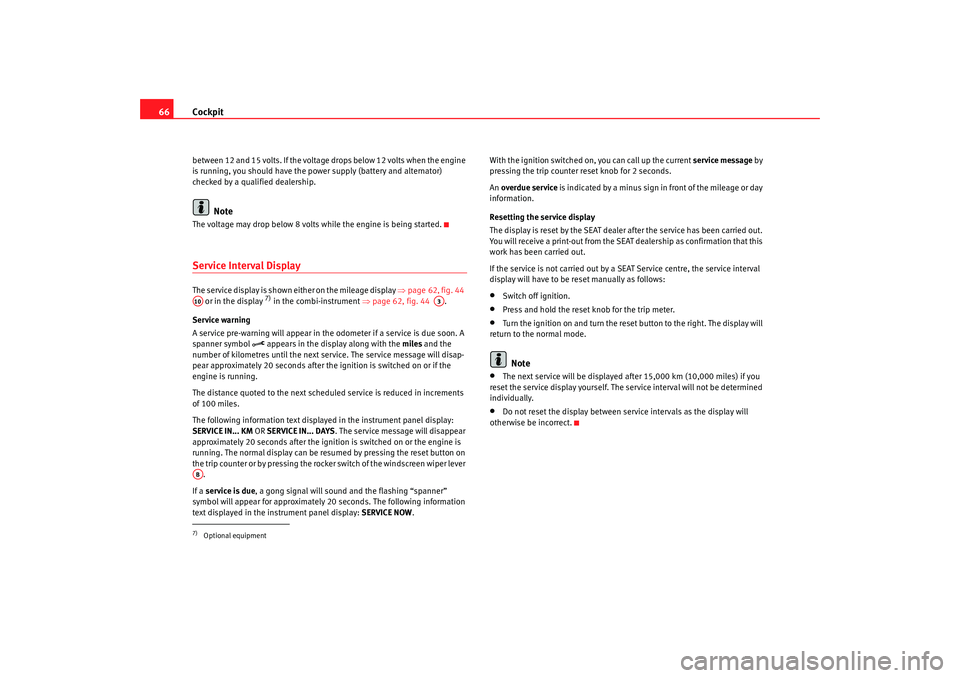
Cockpit
66between 12 and 15 volts. If the voltage drops below 12 volts when the engine
is running, you should have the power supply (battery and alternator)
checked by a qualified dealership.
Note
The voltage may drop below 8 volts while the engine is being started.Service Interval Display The service display is shown either on the mileage display ⇒page 62, fig. 44
or in the display
7) in the combi-instrument ⇒ page 62, fig. 44 .
Service warning
A service pre-warning will appear in the odometer if a service is due soon. A
spanner symbol
appears in the display along with the miles and the
number of kilometres until the next service. The service message will disap-
pear approximately 20 seconds after the ignition is switched on or if the
engine is running.
The distance quoted to the next scheduled service is reduced in increments
of 100 miles.
The following information text displayed in the instrument panel display:
SERVICE IN... KM OR SERVICE IN... DAYS . The service message will disappear
approximately 20 seconds after the ignition is switched on or the engine is
running. The normal display can be resumed by pressing the reset button on
the trip counter or by pressing the rocker switch of the windscreen wiper lever .
If a service is due , a gong signal will sound and the flashing “spanner”
symbol will appear for approximately 20 seconds. The following information
text displayed in the instrument panel display: SERVICE NOW. With the ignition switched on, you can call up the current service message
by
pressing the trip counter reset knob for 2 seconds.
An overdue service is indicated by a minus sign in front of the mileage or day
information.
Resetting the service display
The display is reset by the SEAT dealer after the service has been carried out.
You will receive a print-out from the SEAT dealership as confirmation that this
work has been carried out.
If the service is not carried out by a SEAT Service centre, the service interval
display will have to be reset manually as follows:
•
Switch off ignition.
•
Press and hold the reset knob for the trip meter.
•
Turn the ignition on and turn the reset button to the right. The display will
return to the normal mode.Note
•
The next service will be displayed after 15,000 km (10,000 miles) if you
reset the service display yourself. The service interval will not be determined
individually.
•
Do not reset the display between service intervals as the display will
otherwise be incorrect.
7)Optional equipmentA10
A3
AB
alhambra_ingles_0708 Seite 66 Mittwoch, 10. September 2008 10:55 10
Page 69 of 295
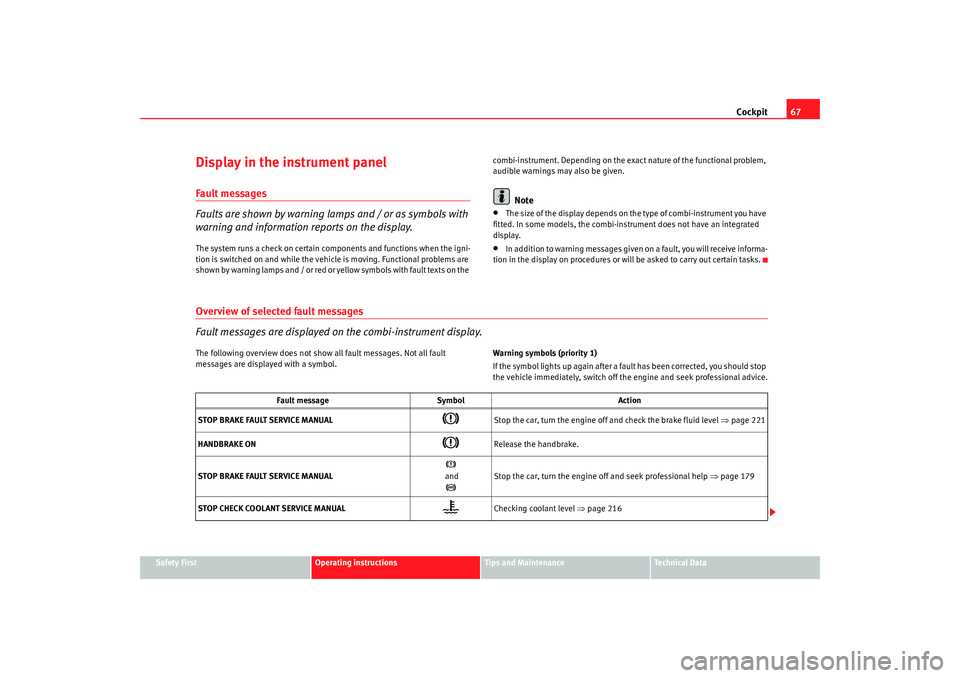
Cockpit67
Safety First
Operating instructions
Tips and Maintenance
Te c h n i c a l D a t a
Display in the instrument panel Fault messages
Faults are shown by warning lamps and / or as symbols with
warning and information reports on the display.The system runs a check on certain components and functions when the igni-
tion is switched on and while the vehicle is moving. Functional problems are
shown by warning lamps and / or red or yellow symbols with fault texts on the combi-instrument. Depending on the exact nature of the functional problem,
audible warnings may also be given.
Note
•
Th e size o f t h e d isp l ay d e p en ds on th e ty p e o f com b i - ins tr u m e n t y ou h av e
fitted. In some models, the combi-instrument does not have an integrated
display.
•
In addition to warning messages given on a fault, you will receive informa-
tion in the display on procedures or will be asked to carry out certain tasks.
Overview of selected fault messages
Fault messages are displayed on the combi-instrument display.The following overview does not show all fault messages. Not all fault
messages are displayed with a symbol. Warning symbols (priority 1)
If the symbol lights up again after a fault has been corrected, you should stop
the vehicle immediately, switch off the engine and seek professional advice.
Fault message
Symbol Action
STOP BRAKE FAULT SERVICE MANUAL
Stop the car, turn the engine off and check the brake fluid level ⇒page 221
HANDBRAKE ON
Release the handbrake.
STOP BRAKE FAULT SERVICE MANUAL
and
Stop the car, turn the engine off and seek professional help ⇒page 179
STOP CHECK COOLANT SERVICE MANUAL
Checking coolant level ⇒ page 216
alhambra_ingles_0708 Seite 67 Mittwoch, 10. September 2008 10:55 10
Page 71 of 295
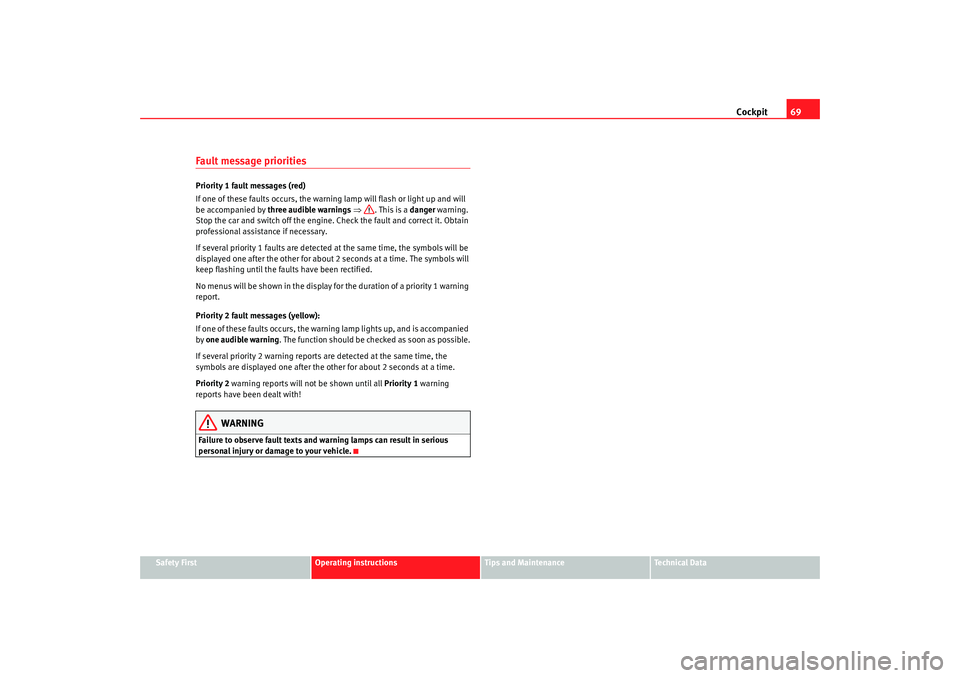
Cockpit69
Safety First
Operating instructions
Tips and Maintenance
Te c h n i c a l D a t a
Fault message prioritiesPriority 1 fault messages (red)
If one of these faults occurs, the warning lamp will flash or light up and will
be accompanied by three audible warnings ⇒ . This is a danger warning.
Stop the car and switch off the engine. Check the fault and correct it. Obtain
professional assistance if necessary.
If several priority 1 faults are detected at the same time, the symbols will be
displayed one after the other for about 2 seconds at a time. The symbols will
keep flashing until the faults have been rectified.
No menus will be shown in the display for the duration of a priority 1 warning
report.
Priority 2 fault messages (yellow):
If one of these faults occurs, the warning lamp lights up, and is accompanied
by one audible warning . The function should be checked as soon as possible.
If several priority 2 warning reports are detected at the same time, the
symbols are displayed one after the other for about 2 seconds at a time.
Priority 2 warning reports will not be shown until all Priority 1 warning
reports have been dealt with!
WARNING
Failure to observe fault texts and warning lamps can result in serious
personal injury or damage to your vehicle.
alhambra_ingles_0708 Seite 69 Mittwoch, 10. September 2008 10:55 10